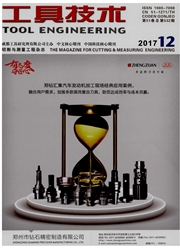

 中文摘要:
中文摘要:
通过分析旋转超声滚压加工特点以及加工机理,确定旋转超声滚压加工过程的有效滚压时间,结合赫兹接触理论建立滚压力与滚压深度的关系模型。进行钛合金TC4旋转超声滚压加工实验,利用测力仪采集超声滚压过程中的滚压力,利用白光干涉仪观察加工表面形貌,使用光学显微镜观察垂直于工件表面方向的微观结构,从表面形貌和微观结构的角度分析滚压深度与滚压力的对应关系。实验研究结果表明,旋转超声滚压力与滚压深度存在线性比例关系,且模型预测结果与超声滚压加工试验测试结果吻合。将滚压力与工件表面形貌的关系转化为滚压深度与工件表面形貌的关系,建立滚压深度与工件表面形貌的对应关系,以指导加工参数中合理滚压深度的选择。
 英文摘要:
英文摘要:
The effective burnishing time in rotary ultrasonic burnishing is determined with by analyzing machining mechanism and characteristics of rotary ultrasonic burnishing operation. The relationship between burnishing force and burnishing depth in rotary ultrasonic burnishing is firstly modelled based on the Hertz contact theory. The relational model is then applied to predict the burnishing force. Experiments of rotary ultrasonic burnishing of titanium alloy TC4 are carried out. The burnishing force is measured using a piezoelectric dynamometer,and the machined surface morphology is observed using a white light interferometer. The microstructure perpendicular to the surface of the ultrasonic burnished workpiece is observed under an optical microscope. The results demonstrate that there is a linear correlation between burnishing force and burnishing depth in rotary ultrasonic burnishing. The experimental results are in good agreement with the theoretical and predictive results. The correlation between burnishing force and surface morphology is discussed. The research results will be beneficial for the appropriate selection ofburnishing depth.
 同期刊论文项目
同期刊论文项目
 同项目期刊论文
同项目期刊论文
 An experiment-based investigation on surface corrosion resistance behaviors of aluminum alloy 7050-T
An experiment-based investigation on surface corrosion resistance behaviors of aluminum alloy 7050-T 期刊信息
期刊信息
